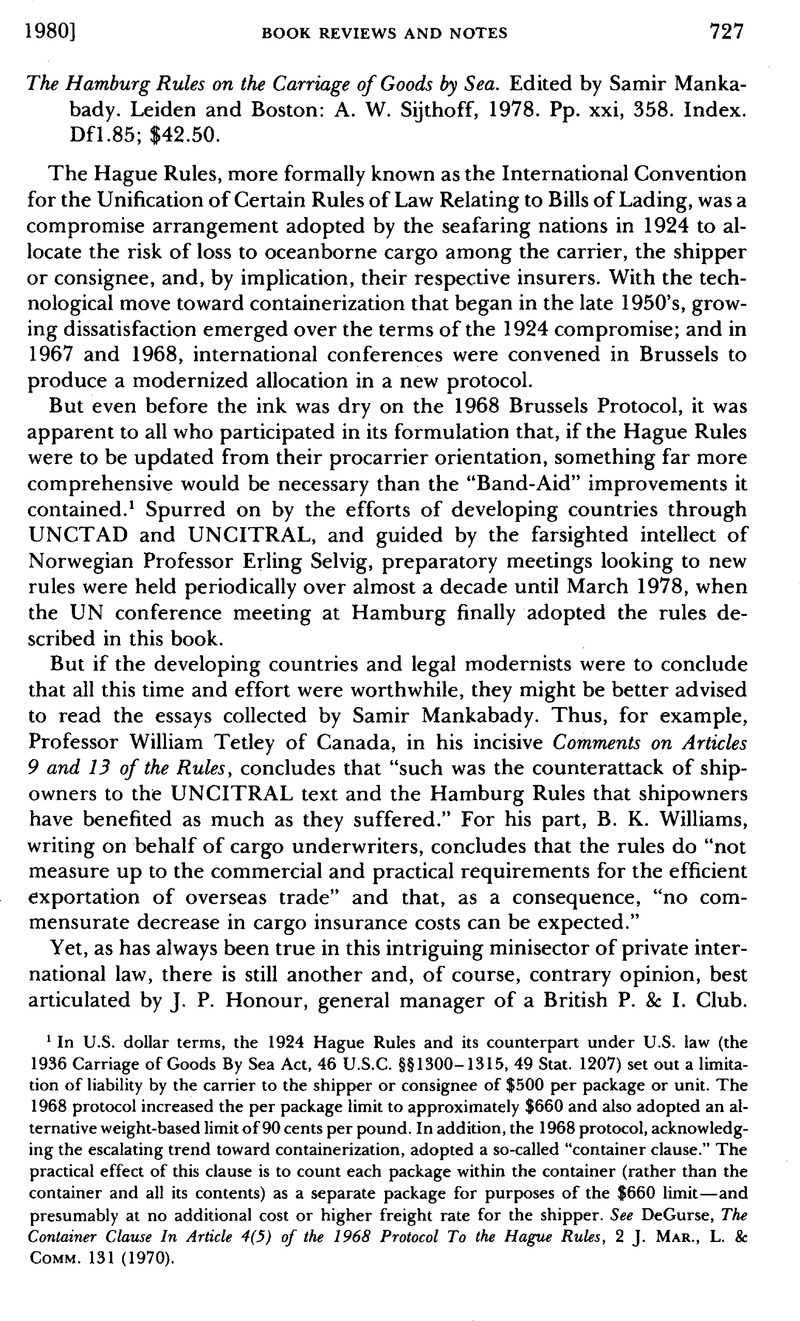No CrossRef data available.
Published online by Cambridge University Press: 27 February 2017

1 In U.S. dollar terms, the 1924 Hague Rules and its counterpart under U.S. law (the 1936 Carriage of Goods By Sea Act, 46 U.S.C. §§1300-1315, 49 Stat. 1207) set out a limitation of liability by the carrier to the shipper or consignee of $500 per package or unit. The 1968 protocol increased the per package limit to approximately $660 and also adopted an alternative weight-based limit of 90 cents per pound. In addition, the 1968 protocol, acknowledging the escalating trend toward containerization, adopted a so-called “container clause.”The practical effect of this clause is to count each package within the container (rather than the container and all its contents) as a separate package for purposes of the $660 limit—and presumably at no additional cost or higher freight rate for the shipper. See DeGurse, , The Container Clause In Article 4(5) of the 1968 Protocol To the Hague Rules, 2 J. Mar., L. & Comm. 131 (1970)Google Scholar.
2 See 49 U.S.C. §20 (11); see also Missouri Pacific R. v. Elmore & Stahl, 377 U.S. 134 (1964). There is no evidence in U.S. law or practice that any arguably higher insurance rates that a U.S. rail or motor carrier might pay to cover his insurer's-type liability has had any impact on the amount of that carrier's freight rates for particular commodities.
3 The only slight defect that this reviewer could find with the book appears in Mankabady's own comprehensive and otherwise excellent introductory comment, where he implies (p. 102) that choice-of-forum clauses in bills of lading are enforced in the United States and that Muller v. Swedish American Lines, Ltd., 224 F. 2d 806 (2d Civ. 1955), is still viable U.S. law on the subject. In fact Muller was expressly overruled by Judge Friendly's decision in Indussa Corp. v. S. S. Ramborg, 377 F. 2d 200 (2d Civ. 1967). See Mendelsohn, , Liberalism, Choice of Forum Clauses,and the Hague Rules, 2 J. Mar. L. & Comm. 661 (1971)Google Scholar. While a choice-of-forum clause was upheld in M/S Bremen v. Zapata Off-Shore Co., 407 U.S. 1 (1972), it was not in the context of Cogsa, and in addition, the contracting parties enjoyed equal bargaining strength. See Gilmore & Black, The Law of Admiralty 145 n.23 (2d ed. 1975). In any event, the frequently vexatious problem of choice of forum was solved by the Hamburg conferees when they wisely adopted Article 21, providing a plaintiff/claimant with 6 different choices of forum in which to bring suit. This type of plaintiff/claimant choice clause was first proposed by the U.S. Government at the 1967 Brussels Conference for the Convention on Luggage Liability, and it has since become almost standard language in all subsequently adopted private international law limitation conventions. See Mendelsohn, , A Conflict of Laws Approach to the Warsaw Convention, 33 J. Air L. & Comm. 624, 629 (1967)Google Scholar. It works effectively to clarify the law, avoid needless litigation, and provide the claimant (whether shipper, consignee, or passenger) with a convenient forum if suit must be brought
4 Mr. Mendelsohn was one of the U.S. Government delegates to the 1967 and 1968 Brussels Conferences. In 1969, following entry into the private practice of law, he served as a consultant to UNCITRAL, coauthoring with Professor David Sassoon a comprehensive study on the Hague Rules.